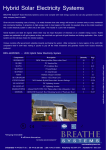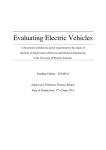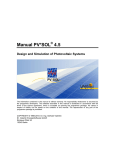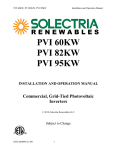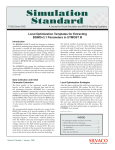Download 4ep.1.1 how well do pv modelling
Transcript
4EP.1.1 HOW WELL DO PV MODELLING ALGORITHMS REALLY PREDICT PERFORMANCE ? Steve Ransome BP Solar UK Chertsey Road, Sunbury on Thames, TW16 7XA UK Tel: +44 (0)1932 775711 [email protected] ABSTRACT: • • • • • • Grid connect PV Sizing programs predict annual energy output in kWh of arrays of solar modules. These are at specified locations and array orientations; using databases of weather, module and inverter performance with user defined values for dirt, mismatch, wiring losses etc. The programs will usually predict performance ratios of 75-80% (approximately what will be achieved in real measurements). This paper looks to see if the programs model everything correctly, or if are there sufficient unknowns and user defined inputs so that predictions and output happen by chance to coincide to within a few percent. Some differences were found between measurements and predictions from commercial modelling programs including both the distribution of insolation and the performance of solar modules vs. irradiance. This paper compares and contrasts algorithms and assumptions used in several commercially available Sizing programs with real outdoor logged data predominantly from ISET Kassel, Germany and BP Solar’s factory roof in Sydney, Australia. It concludes that whereas Sizing programs may use the best available algorithms to help to minimise avoidable losses due to poor component selection, shading, thermal problems etc. the inaccuracies in the kWh predictions due to unknowns such as actual/nominal Pmax, actual weather data and dirt/shading losses mean the absolute values cannot be taken as accurate to within ~5%. Keywords: Modelling, Simulation, Performance 1) INTRODUCTION BP Solar have been involved in long term outdoor PV performance studies of BP Solar’s and competitors’ products since 1998 with IV swept, maximum power point tracked or grid connected modules and arrays at many sites worldwide plus a wide variety of cell technologies. [1] Models have been developed with these data to characterise the performance under the wide variety of weather conditions. Large ac arrays using similar modules have been logged to see how they actually performed and compared with the dc data. [2][3] Some of the modelling in commercially available sizing programs has been found to differ from real outdoor measurements (for example both the distribution of insolation vs irradiance and the PV module efficiency vs irradiance) or are absent (e.g. modelling spectral response particularly for multi junction devices or the thermal and voltage dependency of inverters) yet predictions of kWh/kWp are routinely quoted to 4-5 significant figures despite uncertainties with some of these critical yield determining input parameters that can be of the order of a percent or more each. While commercial sizing programs are very useful in helping to design systems to minimise losses (e.g. by matching optimal inverter power to PV arrays, calculating thermal properties of roof mounting and the effect of any shading obstructions), their estimated kWh/kWp values are imprecise due to the uncertainty of some of the inputs and differences seen between modelled and measured performance. This paper only discusses grid connect sizing programs (it does not talk about battery storage, pump or hybrid inputs including wind and diesel) but details of the plane of array calculations and PV performance algorithms can be considered in these types of systems. Definitions of some of the terms used are in appendix A. 2) SIZING PROGRAM METHODOLOGY Most PV sizing programs predict kWh/year energy output by using a methodology similar to the following list:- Input site data : site location (latitude, longitude and elevation) , array orientation (tilt and azimuth) Input component type data: types of PV modules, inverters, BOS components. Choice of component numbers : Guide the user to choose appropriate component numbers such that the values of ratios such as “inverter power”/“module power” are optimal. Check also for voltage limits for PV strings feeding the inverter. Get meteorological data : (horizontal plane insolation, ambient temperature and wind speeds), interpolate from nearby sites if necessary. Divide the year into (usually hourly) intervals Predict weather parameters : (from transition matrices) for each time period on the horizontal plane: Estimate weather parameters (from transition matrices) for each time period on the module tilted plane Using details of the mounting type (e.g. roof integrated, free ventilation etc). Calculate module temperature (from irradiance, windspeed and ambient temperature). Estimate the module dc Pmax under these conditions Calculate the inverter output: Note the model should calculate for turn on, clipping and if the Vmax of the modules is outside Vmpp inverter window. Sum the predicted ac output power over a year to give energy yield radiation and ambient temperature (i) and these will be discussed further. Algorithms based on transition matrices [7] (which store likelihoods of changes between sequential values – for example if one measurement is sunny there may be a higher chance that the next will be sunny too) generate pseudo random series of data with the same sum over a year as the monthly data, plus the ranges, day-to-day persistence and other statistical parameters which should be indistinguishable from real data. Figure 1 illustrates the different solar radiation components that contribute to the horizontal and tilted plane irradiances with the equator to the right. Under clear skies most radiation comes directly from the sun with little scatter off a blue sky; whereas under haze or cloud the beam component is lowered and most radiation impinging on the module comes from scattering off clouds. Note that tilting the plane towards the equator will normally increase the beam component, add some reflection component and decrease the diffuse (as some of the diffuse sky is now behind the module). Often quoted statistics such as “x% of the insolation at a site is diffuse” where x = Diffuse / (Diffuse + Direct) only refer to the horizontal plane. When modules are tilted towards the equator the direct contribution will be higher, the diffuse lower and therefore the diffuse fraction will be lower. 3) WEATHER DATA Sizing programs will usually store weather data for a range of sites in a database in one of three formats:(i) Monthly average insolation (kWh/m²) horizontal plane and ambient temperature values (C) (ii) Typical Hourly data from a “Typical Reference or Meteorological year” [4] for a site. (These are taken usually from “the most typical” periods measured over a period of several years and will not necessarily all be from the same year). (iii) Satellite derived (often every 3 hours from reflections off cloud tops and expected seasonal albedo) [5] Interpolations from nearby sites are needed if no data exists for the place in question [6], this may also need corrections for altitude and latitude. 4) CALCULATING REALISTIC WEATHER SEQUENCES FROM MONTHLY AVERAGES Most of the weather data for sites worldwide comes from monthly averages of horizontal plane global Figure 1: Radiation components on horizontal and tilted plane surfaces The Diffuse:Beam ratio is calculated by first working out the clearness index (figure 2) kT = Gh / Xh which means that it is the ratio of Global Horizontal plane radiation / Extraterrestrial Horizontal radiation. Xh is related to the solar constant (~1357kW/m²) times a ratio related to the earth orbit ellipticity (being less when the earth is furthest from the sun) multiplied by the sine of the solar height. irradiance data. Row 3) Further calculations estimate every minute values of the Global horizontal plane irradiance. Row 4) The fourth row shows the horizontal plane minute data and its diffuse component which is often calculated from the clearness index Figure 2 by an equation such as [9] shown in figure 3 from measured data in ISET. Row 5) Anisotropic diffuse sky algorithms (the diffuse radiation component is brighter near the horizon and around the sun than for most of the sky) such as Perez [10] are then used to calculate the beam and diffuse components on the tilted plane, these are summed with reflected light to form the Global Tilt. Figure 2: Definition of Clearness Index kT = Gh /Xh Figure 3 illustrates a function used in sizing programs to calculate the expected beam fraction from the clearness index (curve) vs measured data from ISET (points). Note that the real weather tends to clump into “dull and diffuse” or “beam and clear” with fewer data points in the middle. This standard model does not seem to fit the measured data well, the reality is that the beam fraction seems to be a constant of ~0.1 up to a clearness index of 0.35, then there is a linear rise to the extreme value of beam fraction=0.9 when clearness index=0.8. Figure 3: Modelling the Beam Fraction from the Clearness Index – showing measured ISET data vs a standard model. Figure 4 illustrates one process used in a commercial meteorological database generating irradiance data. An example is shown for Kassel in March (i.e. equinox). Three successive days are shown from the commercially available model, a cloudy day (left – all diffuse), a clear day (middle, small diffuse component, a classic bell shape curve with peak irradiance ~0.95kW/m²) and an erratic day (right) with peak irradiances up to 1.2kW/m²[8] Row 1) The monthly average horizontal global irradiation from the database for this site and month was 2.3kWh/m²/day. If each day had constant irradiance this would translate to an average of 2.3/12 (day length) = 0.19kWh/m²/hour. Row 2) A random number seed was then used with a Markov transition matrix to generate a series of hourly Figure 4: Irradiance (y-axis kW/m²) vs time from Horizontal Global ”monthly average” to tilted plane “every minute” synthesized by a sizing program. Thermal models are used predict the PV module temperature from the irradiance, module design, mounting type (e.g. close to roof or freely ventilated back) and windspeed and use parameters like the NOCT value which gives the Module Temperature when the Ambient is 20C and there is an Irradiance of 800W/m² and a windspeed of 1ms-1. 5) INSOLATION VS IRRADIANCE: MEASURED VS PREDICTED Hourly weather predictions will usually overestimate the amount of low light level radiation as there are often periods of erratic weather of bright and dull periods, which would be averaged together to intermediate irradiances in hourly data. During erratic weather (changeable between sunny and cloudy) the PV performance is dominated by the bright periods (where irradiance can be 20% above expected clear skies due to extra reflections by bright clouds) but the PV temperature will be up to 10C lower than expected as they cool under diffuse conditions and will still be warming up under short periods of bright weather [8]. This is illustrated in figure 5 for periods of constant cloud (left), constant sun (centre) and variable weather (right). In a constantly cloudy period (left) both the irradiance and module temperature will be low, in the constant sun (centre) both the irradiance and module temperature will be high, however in the variable period the temperature will be between those of the sunny and cloudy times as due to the thermal mass it will take time to warm up or cool down and therefore depend on the weather over at least the previous 15 minutes or so (10°C lower temperatures than normal have been measured). Also whereas the irradiance is low when the sun is obscured by clouds, when the sun is shining and there are white clouds around the sun then extra reflections can result in irradiances up to 20% or so greater than from a clear blue sky (the “edge of cloud effect”). This means that on variable sunshine days modules can work at far higher currents (due to the reflections from clouds) and at higher voltages (because of the lower temperatures) which need to be taken into account when designing for peak powers. These effects are non linear and will not be modelled by hourly averages as they rely on transient conditions of the order of a few minutes or less. were seen for Sydney, Australia with modelled data having more insolation at low light than was measured. Figure 6: Measured vs Modelled Insolation vs Irradiance for a 32° tilted array in Kassel, Germany) 6) INSOLATION VS VARIABILITY YEAR TO YEAR IRRADIANCE: Irradiance data will also vary year by year. Figure 7 plots the measured 10 minute- averaged insolation vs irradiance for Kassel for the 8 full years 1999-2006. In all but year 2000 there is a steadily increasing insolation with light level peaking with more irradiance from 0.80.9kW/m² that at lower light levels, for comparison the shaded area gives what the model would suggest indicating that it thinks there is more energy at lower light levels. Figure 5: Illustrating the module temperature and irradiance in constant cloud (left), constant sun (centre) and variable weather (right). Figure 6 plots the Insolation vs Irradiance: the top histogram shows the measured insolation vs irradiance in Kassel for 2003. It can be seen that the highest insolations measured are in the 0.8-0.9kW/m² bin. The same data was replotted every 15secs and much more insolation is seen to occur at higher irradiances up to 1.2kW/m² (much of the apparent irradiance at 0.4 to 0.8kW/m from the hourly data is actually an aggregate of transient irradiances up to 1.2kW/m². The lower histogram shows simulated data from a commercially available meteorological database – the hourly data suggests most insolation occurs at below 0.7kW/m², every minute data implies that the higher irradiances now have increased energy but nowhere near as much as the measured data proves. Similar results Figure 7: 1999-2006 Yearly measured (averaged every 10 minutes) vs hourly modelled insolation vs irradiance for a 32° tilted array in Kassel, Germany 7) DC MODULE POWER PV modules exhibit IV curves as shown in Figure 8. The dc current is almost proportional to the plane of array irradiance and the voltages will fall slightly (by around -0.2 to -0.4%/K) as the temperature rises. The six curves show a multicrystalline module measured in the afternoon of a sunny summer day in January in Sydney, curve 1 was at 12:30 when the Irradiance was 950W/m² and the module temperature was 45C; this was measured every hour until 17:30 when the Irradiance had fallen to 285W/m² and the module had cooled to 31C. Note the grey circles indicating the maximum power voltage Vmp where the value P=I*V has a maximum – for optimum performance the modules must be loaded to this voltage all the time. The MPP voltage has a complicated dependence on both irradiance and temperature and the point is usually found by the MPP tracker by a trial and error algorithm. The irradiance and hence the current can vary rapidly as the sun goes behind or comes out from clouds but the module temperature varies slowly (a step change in irradiance might result in a 15 minute or so ramp to a new steady temperature value). Data from the spec sheet with no obvious way of knowing how different irradiances are modelled; temperature dependency will generally be modelled from supplied temperature coefficients. (iv) Equivalent circuit model. A 2-diode model is needed for best accuracy [11]; the second diode reduces the current at the Pmax point, meaning that a 1-diode model will not be able to reproduce the shape of the IV curve. However some of the parameters are temperature dependent which might not be considered. Outdoors modules are almost never at normal irradiance, usually Air Mass is >1.5, there is always a diffuse component and the temperature is above 25C for the majority of the time. Measurements on BP modules show better performance under low light real conditions than some of these programs suggest. Figure 9 shows the PV efficiency of a BP7180 module measured outdoors and predictions from a sizing model. (Note that outdoors the module will tend to be hotter under higher light levels and also have a bluer spectrum and a lower angle of incidence than the indoor measurements would use). Figure 8: Measured IV curves every hour for a multicrystalline module on a sunny afternoon in Sydney Australia. 8) PV EFFICIENCY VS IRRADIANCE Simulation programs will usually have a method to calculate “efficiency vs irradiance” curves for each module type stored in their databases. (In a production line efficiencies are usually measured under flash simulators at Standard Test Conditions or “STC” under normal irradiance, Air mass AM =1.5 Global, 100% direct beam and at 25C module temperature.) Following are some examples of efficiency vs Irradiance curves that are used in different sizing models. (i) Efficiency vs Irradiance lookup table Often from a module spec sheet with efficiencies at different light levels 200-1000W/m2 (e.g. EN 50380) but at Module Temperature=25C, Angle of Incidence=0, Air Mass=1.5. (ii) Pmax at “high” and “low” irradiance Stored Vmax and Imax at arbitrary “high” and “low” light levels and interpolate a curve between just two points (although mathematically at least 3 points are required for a curve) (iii) Spec sheet Data Figure 9: Efficiency of a BP7180 module measured outdoors vs a PV model from a commercially available sizing program corrected to a module temperature of 25C. A comparative study was done at ISET comparing two of BP Solar’s crystalline Si products (a 7180 mono “Laser Grooved buried contact Saturn” and a 3160 multi Si) vs a CIS and a triple junction a-Si thin film module to determine how they performed against light level (figure 10) and beam fraction (figure 11). Note the much higher non temperature corrected efficiency of the crystalline modules against that of the thin film and the fact that the crystalline relative efficiency is at least as good at lower light levels and under diffuse conditions. The lower histograms show the relative amounts of plane of array insolations at different irradiance and beam fraction bins – there is more energy at high irradiance and high direct fraction than at low light or diffuse conditions even in Germany. Weather Parameter and Module Efficiency Irradiance (kW/m²) Figure 10: Non temperature corrected module efficiency (left y-axis) and % of insolation (right y-axis) for four modules against Irradiance (high irradiance to the right) for 1 year in ISET. Figure 11: Non temperature corrected module efficiency (left y-axis) and % of insolation (right y-axis) for four modules against Beam fraction (diffuse=left direct=right) for 1 year in ISET. 9) CORRELATION PARAMETERS OF METEOROLOGICAL Some indoor modelling tests attempt to measure performance by separating into independent values for temperature and irradiance (for example measuring efficiency vs irradiance at a constant temperature, then efficiency vs temperature at a given irradiance). However under real conditions all meteorological parameters are correlated. Table 1 shows how many parameters such as module temperature tend to correlate with irradiance. This means that any attempt to understand the performance versus one of these parameters will necessarily involve the others. An example is the claim that some thin film modules have been measured to have a positive gamma (= 1/Pmax * dPmax/dT) coefficient. Gottschalg et al proved that for hotter measurements the spectrum was usually bluer and therefore it was a spectral effect rather than just thermal [12]. Table I: How Weather related parameters tend to correlate under “poor” and “good” solar weather conditions “Poor solar weather” less important for Energy Yield Lower Irradiance (dull and/or dawn/dusk) A) Ambient Temperature (C) B) Module Temperature (C) C) Angle of incidence (° from normal incidence = 0 if facing sun) D) Solar height Æ Spectrum Lower Temperature Lower Temperature Higher AOI (i.e. grazing angles) E) Beam Fraction More Diffuse radiation F) Temperature Compensated efficiency (PFT) Flat at lower light levels due to good capture of diffuse light Lower sun Æ More red rich “Good Solar Weather” more important for Energy Yield Higher Irradiance (bright, nearer noon) Higher Temperature Higher Temperature Lower AOI (i.e. nearer normal incidence) Higher sun Æ More blue rich More Direct radiation Flat with high Irradiance falling slowly due to reflection loss at high AOI Figure 12 plots these values A) to F) (y-axes) in Table I vs irradiance (x-axis). “Clear sky/mostly beam” data is shown in white, “dull data/mostly diffuse” in black. It can be seen that high beam fractions occur under clear conditions, that there is an almost linear fall in angle of incidence as the irradiance rises under clear skies and also the irradiance is highest at the greatest solar height. The ambient temperature rises slowly with irradiance but the module temperature rises much faster. MEASURED DC AND AC Many of the data values used in modelling are not known precisely. Table 2 gives some of the unknowns and any uncertainties Table 2: Met Data and their uncertainty Data for Meteorological database Met Data site irradiance sensor Pyranometer Reference cell Figure 12 : Correlations between various meteorological parameters (y-axes) A) Ambient Temperature B) Module Temperature C) Angle of incidence D) Solar height E) Beam Fraction F) Temperature Compensated efficiency and the irradiance (x-axis) for ISET, Germany. Interpolation from nearby Met Sites Tilted Plane Irradiance calculation Data for Modules database Module Calibration vs Certification Lab Module Performance in Band e.g. 200-205Wp Site Data Site Pyranometer Calibration and Performance Year to Year spread/Climate Change Dirt 10) INVERTERS Most sizing programs store data to model inverters based on their efficiencies vs input power or euro efficiency rating ηEU where ηEU=0.03η5+0.06η10+0.13η20+0.1η30+0.48η50+ 0.2η100 and also their mpp voltage limits. The latter is usually tested at extreme conditions of the lowest and highest module temperatures. However reports by Baumgartner et al [13] show that the inverter efficiency depends to a large extent on the Vmp Voltage. A report from ISET [14] proves that the inverter efficiency is also affected by the internal inverter temperature and can differ widely between manufacturers. To model both of these effects the Inverter databases would need to contain efficiency vs Voltage and Temperature coefficients or limits. The Vmp of the module string can be calculated and applied to the inverter; the temperature of the inverter must also be calculated, models must input how and where the inverter is installed, for example in sunshine, under an array or in a room which may contain temperature control or not. As the efficiencies of inverters falls at low light levels (resulting in the input power being a small fraction of the nominal power) manufacturers sell multi stage inverters which switch off fractions of the inverter capacity resulting in a higher PV power in/Inverter power and hence better performance at low light. 11) UNCERTAINTIES OF KWH PREDICTED AND Measurement Data Power Uncertainty ±2-3% [suppliers] ±5% [suppliers] [Meteonorm] better than year to year variation [Meteonorm] better than year to year variation ± 2% ~5W/200W = 2.5% range i.e. ±1.25% ± 2-3% ~ ± 4% (may be less in sunnier regions) 0 to -4% in temperate regions with random rain ; 0 to ~-25% in arid regions with seasonal rain and dust[15] Inverter manufacturers ±3% 12) COMPARATIVE kWh/kWp TESTS BP Solar in common with other institutes measure the dc performance of PV modules in the field. Before comparing measured energy yields it is important to check each and every measurement to ensure 1) Modules are being measured correctly 2) Downtime and rogue values are extracted 3) Missing data interpolated properly 4) Shaded data corrected or ignored When calculating the kWh/kWp values, the kWh can refer to 1) kWp nameplate. Note that most manufacturers have a nameplate band of for example 5Wp in a 200Wp rating so that extreme modules of 200.01 and 204.99 could both appear as the same nameplate rating, resulting in an approximately 2.5% variation from the best to the worst modules. 2) kWp flash tester. Rather than use the manufacturer’s flash tester rating the institute will often remeasure modules or send them to an independent test facility for checking. These test facilities guarantee accuracy often to ±2% meaning that otherwise identical modules with the same kWh yield would appear to have ±2% variability in kWh/kWp between the most optimistic and pessimistic calibrations. Where crystalline modules are usually stable, thin films can change markedly in their early stages up to 3months or even a year. The accuracy of comparative tests of AC strings relies on the inverters being identical and performing well in for example Vmax tracking, otherwise this makes comparing the kWh/kWp less meaningful. 13) UNCERTAINTIES OF USER DEFINED INPUTS The user will be presented with a range of options to choose when designing a system, not all of them are known and the user will have to guess. Some of these are shown in table 3. (It does not cover degradation, thermal annealing or spectral effects which are greater on multi junction devices) production batch, is expected to be worse in runs with wider ranges of Isc. Figure 13 highlights some of the expected losses due to the user’s choices and some of the calculations. Indicated are approximate limits of the best and worst that might be expected (although these are not hard limits – it is always possible to have a site with much poorer shading for example). The typical line indicates a choice that would result in a Performance Ratio of ~75%. This however is not a validation that these choices occurred, higher values of some would compensate for lower values of others. Table 3: Some user defined losses and calculations Loss 1)Pmax/Pnom 2)Shadow 3)Snow 4)Dirt 5)AOI 6)Thermal 7)DC Wiring 8)MPPT 9)Inverter 10)Clipping 11)Transformer 12)AC Wiring 13)Downtime 14)Mismatch Comment Depends on Calibration uncertainty and module performance within band. LID can affect Si modules by a few %, degradation of Thin Film modules can be much higher. Estimated from 3D geometry. Should depend on stringing arrangement Available from TMY data or “best guess” but worst loss will depend on snow and sun together. May increase around 0.25%/dry day, falls to 0 after very wet day (for example >5mm rain)[15] Estimate the loss as the angle of incidence increases, will be lower for ARC modules, more apparent for clear skies than diffuse conditions. Calculated from mounting method, Irradiance, Windspeed, NOCT and gamma Bulk resistivity of cables * length /cross sectional area Ability of tracker to find MPP: may hit end stop limits under extreme temperatures, won’t be perfect for shaded sites. Efficiency vs input power : will also depend on Inverter input voltage [13] and temperature [14] Undersizing the inverter will result in clipping at high Irradiance – Oversizing will result in low ac efficiency or turn on losses at lower light levels Transformer losses if applicable Bulk resistivity of cables * length /area Guesses for random outages and scheduled maintenance. Depends on dissimilarity of modules connected in series but will depend on irradiance, cell technology and temperature. May vary due to Figure 13: Performance Ratio after each loss stage for “Best”, “Worst” and typical arrays. Figure 14 shows how unknowns in inputs result in more uncertainty in the output obtained. For example A might be a hypothetical Module Power, B might be Dirt. The power output will depend on A * B. The graph shows the result of a simulation of 10000 runs assuming Gaussian distributions; the legend shows the mean ± standard deviations. The new mean (96.4%) is the product of the input means (98.8% x 97.6%) as expected. The new standard deviation is greater than either of the input standard deviations. Here we have shown only the result of two unknowns, in reality there will be at least the 13 values shown in figure 13. Figure 14: The standard deviation increases after each uncertainty in the input definitions. Figure 15 shows a simulation where all 13 values for mean and slightly narrower 3-sigma limits from Figure 13 were entered into a simulator and run 2000 times. It shows a resultant Performance Ratio of ~74±5% just from the unknowns in the input values and does not include any contributions to error from weather variability, module performance modelling or power measurement. Figure 15: Distribution in PR expected from the unknowns in figure 13. 14) CONCLUSIONS • • • • • Sizing programs can predict similar performance ratios to what may be achieved namely 75-80%. Meteorological programs seem to overestimate low light level insolation Sizing programs help to minimise avoidable losses due to poor component selection, shading, thermal problems etc. Unknowns such as actual/nominal Pmax, actual weather data and dirt/shading losses mean the absolute values cannot be taken as accurate to within ~5%. Sizing programs do not predict PV performance well but may just coincide with energy output. 15) REFERENCES [1] More than 70 of BP Solar’s technical papers can be found at http://www.bpsolar.com/techpubs [2] S J Ransome, J H Wohlgemuth, S Poropat and E Aguilar “Advanced analysis of PV system performance using normalised measurement data” 31st IEEE PVSC Orlando 2005 [3] Artigao et al “4% Higher Energy Conversion from BP 7180 Modules” 2006 Dresden 21st European PVSEC [4] TMY2 user’s manual http://rredc.nrel.gov/solar/old_data/nsrdb/tmy2/ [5] de Keizer et al “PV-SAT-2 Results of field test of the satellite based PV System Performance check” 2006 European PVSEC Dresden 21st http://www.envisolar.com/factsheets/pvsat_2_validation_ results_staffelstein.pdf [6] http://aurora.meteotest.ch/meteonorm/media/pdf/mn6 _theory.pdf [7] Aguiar and Collares-Pereira “A simple procedure for generating sequences of daily radiation values using a library of Markov transition matrices” Solar Energy Vol 40 No.3 pp276-279 [8] Steve Ransome and Peter Funtan “Why hourly averaged measurement data is insufficient to model pv system performance accurately” 2005 Barcelona 20th European PVSEC [9] D.G. Erbs, S.A. Klein and J.A. Duffie, Estimation of the diffuse radiation fraction for hourly, daily, and monthly-average global radiation, Solar Energy 28 (1982), pp. 293–302. [10] Perez et al “A new simplified version of the Perez Diffuse Irradiance model for tilted surfaces” Solar Energy Vol 39 No.3 pp221-231 [11] S Ransome, J Wohlgemuth and K Heasman “Quantifying PV losses from equivalent circuit models, cells, modules and arrays” [12] R. Gottschalg, T.R. Betts, D.G. Infield, M.J. Kearney (2002). “Experimental Investigation of Spectral Effects on a-Si Solar Cells in Outdoor Operation”. Proceedings of 29th IEEE-PVSC, New Orleans, USA, pp. 1138-1141. [13] MPP Voltage Monitoring to Optimise Grid Connected System Design Rules” http://www.ntb.ch/Pubs/sensordemo/pv/2004_06_mppv_ baumgartner_paris.pdf [14] “Sicherheitsaspekte bei dezentralen netzgekoppelten Energieerzeugungsanlagen -SIDENA Abschlussbericht - Wissenschaftliche und technische Projektergebnisse” [15] “Soiling Analyses at PVUSA” Townsend, T.U. and P.A. Hutchinson, (2000) Proc. ASES-2000, Madison, WI 16) ACKNOWLEDGEMENTS Peter Funtan ISET Kassel Germany, Stephen Poropat BP Solar Australia and other staff at BP Solar worldwide. Also thanks to work experience student Mathieu Fox for technical discussions. APPENDIX A : DEFINITIONS see also IEC 61724 Parameter Gi Description Global Inclined Plane of Irradiance kW/m² TAMB Ambient Temperature C TMOD WS Module Temperature Wind speed Extraterrestrial Horizontal Plane Irradiance Global Horizontal Plane Irradiance Diffuse Horizontal Plane Irradiance Beam Fraction = 1-Diffuse Fraction = 1 – Gd/Gh C ms^-1 Xh Gh Gd BF Units kW/m² kW/m² kW/m² # YR /time YA /time YF /time PR AOI kTh γ Gamma Global Tilted Plane (POA) Insolation = Σ(Gi)/t DC yield YA = Σ(PDC/PNOM)/time AC yield YF = Σ(PAC/PNOM)/time AC Performance Ratio = YF/YR Angle of Incidence Sun - Module Normal "Instantaneous" Horizontal Clearness Index = Gh/Xh Pmax temperature coefficient = 1/Pmax * dPmax/dT kWh/m² /time kWh/kWp /time kWh/kWp /time # ° # %/deg K











